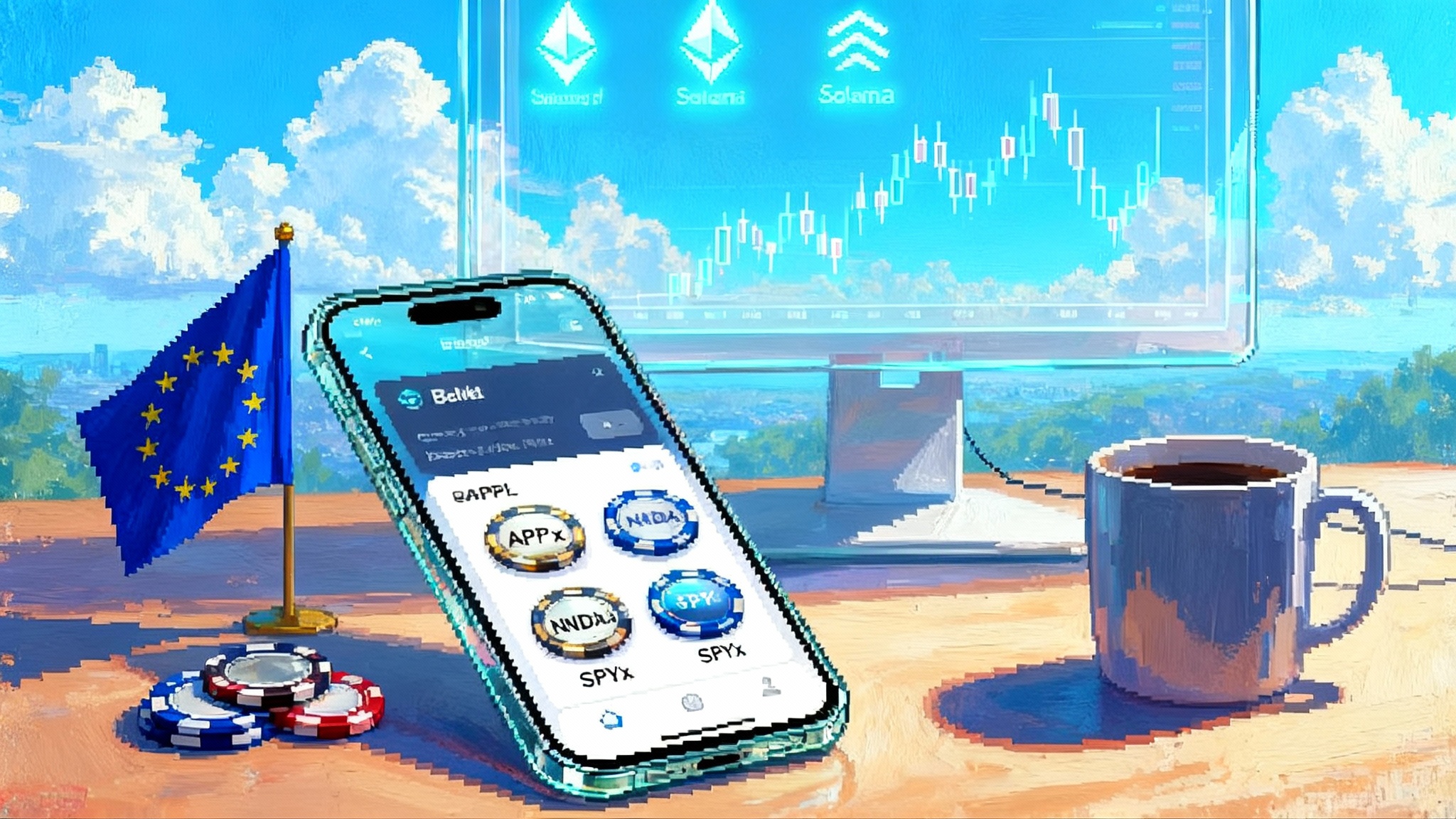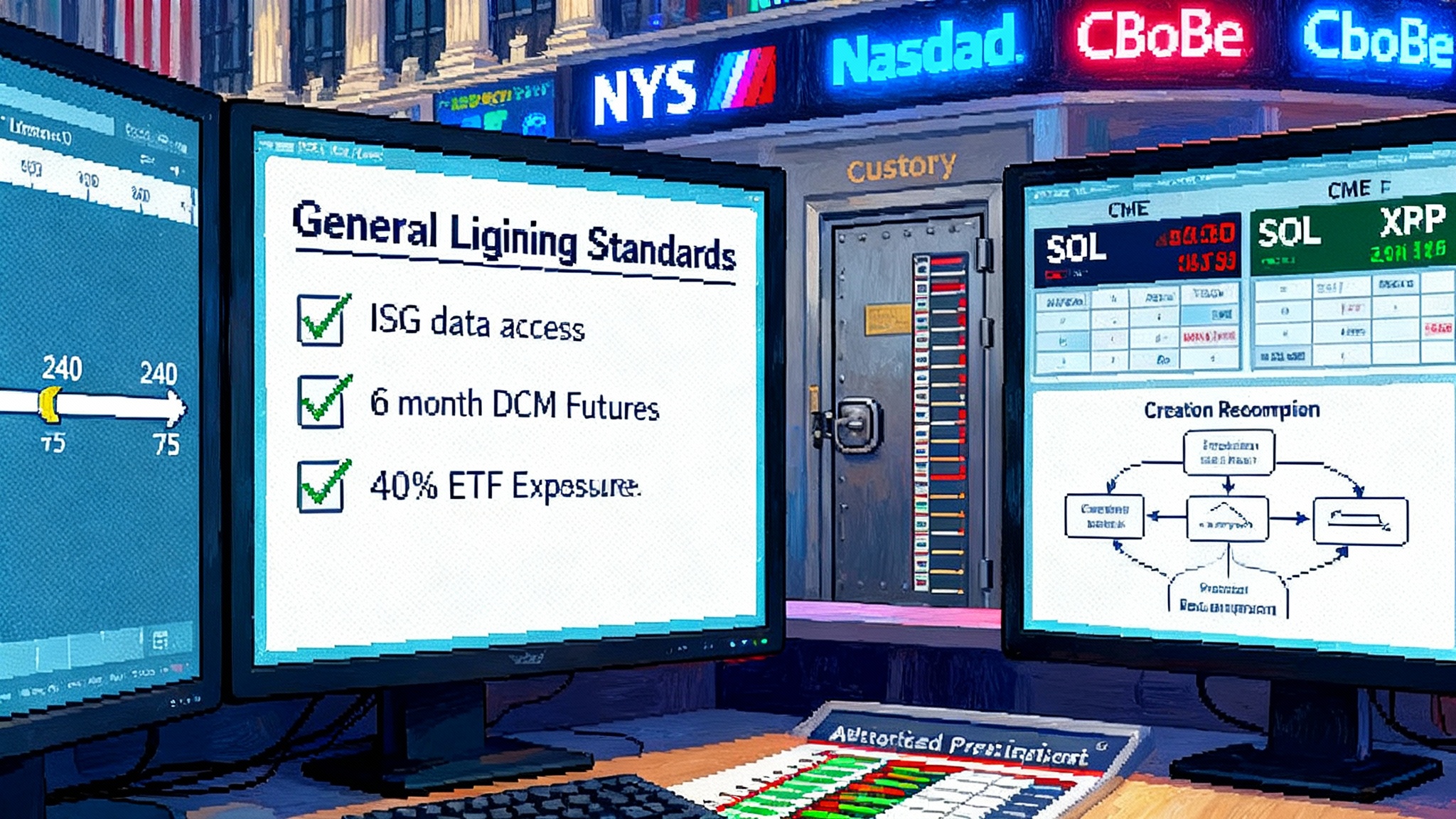Kraken xStocks puts blue chips on chain as Europe opens
Kraken has taken tokenized equities from pilot to production in Europe, adding Ethereum support and self-custody so blue-chip exposure can plug into DeFi. With MiCA setting a clear runway, on-chain equities look set to compound liquidity into 2026.

The week equities stepped onto public blockchains
In September, Kraken extended its xStocks rollout to European Union clients, moving tokenized blue chips from demo to distribution. With a tap in the app, eligible EU users can buy tokens that track Apple, Nvidia, Tesla and other U.S. names, then withdraw those tokens to their own wallets for use across on-chain markets. Kraken describes these as tokenized certificates backed one-for-one by the underlying equity. For scope and caveats, see the official note on the expansion to EU clients in xStocks now available to EU clients.
This push also widened the technical runway. xStocks began on Solana and now live on Ethereum too, the largest smart contract network by usage. That matters because composability on Ethereum is the default. Builders can treat these equity tokens like Lego bricks to assemble lending markets, structured yield vaults and hedging strategies that would take weeks to wire together on traditional rails.
What tokenized stocks really are
Think of xStocks like a claim ticket that tracks the price of a familiar share, rather than the share itself. These tokens do not make you a shareholder in Apple or Nvidia. You get economic exposure to price, and on exchange dividends are handled by increasing your token balance rather than paying out cash. That makes the asset simple to keep on chain, but it also means you should not expect voting rights or corporate actions to flow through as they would in a brokerage account.
Under the hood, tokens are SPL on Solana and ERC 20 on Ethereum. Issuance is handled by a regulated issuer while Kraken acts as venue and on or off ramp. For eligible clients, tokens can be deposited for liquidity or withdrawn for self custody, which opens the door to using equity exposure outside the exchange itself.
Why this matters right now
Three new properties show up the moment a stock becomes a programmable token on a public chain.
- Around the clock access during the work week. On Kraken, xStocks trade 24 hours a day Monday to Friday, with weekend availability in development. Prices still anchor to the underlying equity, but the token can change hands when the stock market is closed. Off hours, spreads may widen, similar to pre market and after hours trading.
- Self custody. You can hold AAPLx or NVDAx in your own wallet, similar to a stablecoin. That brings direct control and reduces venue risk, while putting responsibility on you to safeguard keys and follow local rules.
- DeFi composability. Once a token is in your wallet on Ethereum or Solana, it can be recognized by protocols for collateral, covered call vaults, basis trades and structured products. For context on throughput roadmaps that matter for this use, see Firedancer plans to uncap Solana blocks and Polygon’s bet on stateless speed.
A simple example to make it concrete
Say you are long Apple and want to keep that exposure while earning a predictable yield. In the old world, you might sell covered calls through a broker, accept margin and tax constraints, then track it all in a spreadsheet. In the on chain world, you could do something functionally similar with AAPLx once relevant vaults support it. You would move AAPLx to a self custodial wallet, deposit it to a vault that writes calls at a set delta, and receive a tokenized receipt that represents your share of the strategy. You could then borrow a small amount of stablecoins against that receipt, rebalance weekly and see transparent performance on chain.
The point is not that every vault exists today. It is that the atomic pieces do. We already have tokens for blue chip equity exposure, wallets that secure them, oracles that price them and protocols that can accept them as inputs. The rest is software and risk design, a direction that dovetails with Aave V4 as a modular hub.
The catalysts that will pull this forward
- Distribution to the biggest DeFi surface area. Ethereum support puts xStocks into the network many builders target first, which should accelerate integrations in collateralized lending, structured yield and automated market making. The ecosystem is chain plural in a way that mirrors how real finance is venue plural.
- Exchange integrations and the network effect. Multiple venues listing and routing these assets means more order flow, better price discovery and richer tooling. Network effects in finance look like data feeds, analytics, collateral support and borrow markets appearing in quick succession.
- European clarity and the MiCA timetable. Europe’s Markets in Crypto Assets framework created a common rule set and an 18 month transition window that can run as late as July 1, 2026. Providers operating under national rules can continue during that window while applying for full authorization. See ESMA’s overview in the MiCA implementation timeline.
- Competitive validation. When several large consumer platforms introduce similar products at once, vendors and developers pay attention. More competition means more routes to liquidity, faster normalization of custody and clearer user expectations.
The constraints that keep this grounded
- U.S. geofencing. Kraken’s materials are explicit that xStocks are not available in the United States or to U.S. persons. That limits both retail and certain institutional adoption in the world’s deepest equity market. It will take new approvals and perhaps new market structures to change this.
- No shareholder rights. These are price tracking instruments, not direct claims on the corporate issuer. That is fine for many uses, but it must be said plainly to avoid investor misunderstanding about votes and corporate actions.
- Market microstructure. Tokenized equities can trade when the stock market is closed, but creation and redemption still tie back to real shares. During off hours, liquidity will lean on market makers who carry basis risk until the reference market reopens.
- Risk plumbing. Collateralizing equity tokens requires oracles that read both the token price and the underlying. It requires clear rules for halts, for extreme gaps on earnings and for corporate events like splits. Protocols should start with conservative loan to value ratios and dynamic buffers that widen before earnings or macro events.
Why tokenized equities, not altcoins, could drive the next wave of on chain liquidity in 2026
- The addressable market is larger by orders of magnitude. Global equity float dwarfs the combined value of non stable crypto assets. Even a small slice of tokenized equity used as DeFi collateral can produce more lendable supply than a typical altcoin cycle.
- The risk and return profile fits institutions. Equity exposures have implied volatilities, earnings calendars and mature derivatives markets that quant desks already know how to hedge, which eases collateral approvals.
- Real world cash flows. Dividends and index rebalances provide natural flows that structured product teams can use to manufacture yield or risk premia on chain.
- Composability compounds utility. Put an equity token in a self rebalancing vault, wrap the vault token in a lending market and use that receipt to mint a buffered note that caps upside. Each step adds utility and can be audited on chain.
- Regulatory glide path in Europe. With MiCA live and a clear transition calendar, teams can plan licensing and product geography rather than guess. A planable rule set tends to attract patient liquidity that stays through cycles.
How builders, investors and regulators can act now
- Builders. Design for chain neutrality. Support Solana and Ethereum at minimum, avoid a single oracle and make dividend logic transparent. Publish conservative risk parameters for any collateral pools and widen buffers before known events. Build warm shutdown switches for halts.
- Investors. Treat tokenized equities as a new wrapper around a familiar exposure. Start with long only positions you can self custody. If you explore collateral, limit initial loan to value and avoid leverage through earnings. Confirm you are in an eligible jurisdiction and remember that these tokens do not deliver shareholder rights.
- Regulators. Focus on disclosures and event handling. Require apps to show a clear rights comparison between tokens and shares. Specify how halts propagate and how oracles should behave around earnings gaps. Encourage standardized dividend treatment and incident reporting aligned with MiCA’s consumer protection goals.
The bigger picture
If the last cycle was stablecoins teaching the internet what a reliable on chain dollar feels like, the next may be tokenized equities teaching the internet what programmable public markets feel like. Kraken’s EU expansion and Ethereum support move the idea from conference panels to real products in real wallets. The unlock is not just access. It is composability. When equity exposure can flow into collateral, hedging and structured products with a few contract calls, you get liquidity that compounds. That is why tokenized equities are a credible candidate to lead the next wave of on chain activity in 2026.








